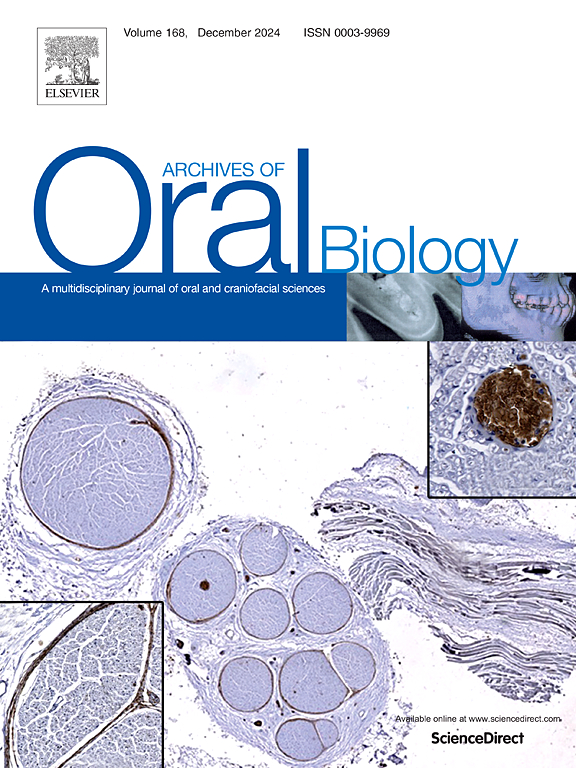使用可移动假体治疗老年肥胖患者的下颌运动和吞咽阈值
IF 2.1
4区 医学
Q2 DENTISTRY, ORAL SURGERY & MEDICINE
引用次数: 0
摘要
目的在成年人中,肥胖与咀嚼能力下降有关。然而,在部分有牙的老年人中,很少有证据表明肥胖与咀嚼运动有关。本研究旨在评估肥胖对使用可移动假体的肥胖老年人下颌运动和吞咽阈值的影响。设计将38名部分无牙老年人分为肥胖组(n = 18,71.11 ± 5.18岁)和对照组(n = 20,70.00 ± 5.36岁)。所有的参与者都接受了新的义肢。6个月后,使用下颌追踪方法评估他们的下颌运动范围、咀嚼时下颌运动和吞咽阈值。资料比较采用独立t检验(α = 5 %)。结果与对照组相比,老年肥胖患者的垂直开口(34.65 mm±2.26)和咀嚼周期次数(600.53 ms±68.05)较少,下颌闭合时间(242.15 ms±40.05)较长;所有p & lt; 0.05)。此外,肥胖组的中位颗粒尺寸更大(4.89 ± 0.70),吞咽前咀嚼周期更少(20.44 ± 4.51;p & lt; 0.001)。结论肥胖成人可摘义齿佩戴者咀嚼时下颌活动范围缩小,吞咽阈相关咀嚼功能受损。这些发现可能有助于理解肥胖与咀嚼功能之间的复杂关系。本文章由计算机程序翻译,如有差异,请以英文原文为准。
Mandibular movements and swallowing threshold in older adults with obesity using removable prostheses
Objective
In adults, obesity has been associated with reduced chewing ability. However, evidence for the association of obesity with chewing movements in partially edentate older adults is scarce. This study was conducted to evaluate the influence of obesity on the mandibular movements and swallowing thresholds of obese older adults using removable prostheses.
Design
Thirty-eight partially edentulous older adults were assigned to obese (n = 18, 71.11 ± 5.18 years) and control (n = 20, 70.00 ± 5.36 years) groups. All participants received new prostheses. Six months later, their mandibular range of motion, jaw movements during chewing, and swallowing thresholds were assessed using jaw-tracking methods. The data were compared using the independent t test (α = 5 %).
Results
Relative to controls, older adults with obesity had lesser vertical apertures (34.65 mm ± 2.26), and masticatory cycle times (600.53 ms ± 68.05), and longer mandibular closing times (242.15 ms ± 40.05; all p < 0.05). Additionally, the obese group exhibited larger median particle sizes (4.89 ± 0.70) and fewer chewing cycles before swallowing (20.44 ± 4.51; both p < 0.001).
Conclusions
Older adults with obesity wearers of removable dentures had reduced jaw range of motion and mandibular movements during chewing, and impaired masticatory function related to swallowing threshold relative to controls. These findings may contribute to the understanding of the complex relationship between obesity and masticatory function.
求助全文
通过发布文献求助,成功后即可免费获取论文全文。
去求助
来源期刊

Archives of oral biology
医学-牙科与口腔外科
CiteScore
5.10
自引率
3.30%
发文量
177
审稿时长
26 days
期刊介绍:
Archives of Oral Biology is an international journal which aims to publish papers of the highest scientific quality in the oral and craniofacial sciences. The journal is particularly interested in research which advances knowledge in the mechanisms of craniofacial development and disease, including:
Cell and molecular biology
Molecular genetics
Immunology
Pathogenesis
Cellular microbiology
Embryology
Syndromology
Forensic dentistry
 求助内容:
求助内容: 应助结果提醒方式:
应助结果提醒方式:


